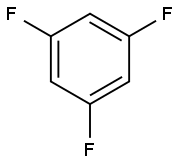2,4,5-Trifluorobenzonitrile
- CAS NO.:98349-22-5
- Empirical Formula: C7H2F3N
- Molecular Weight: 157.09
- MDL number: MFCD00013289
- SAFETY DATA SHEET (SDS)
- Update Date: 2025-07-16 09:55:26

What is 2,4,5-Trifluorobenzonitrile?
Chemical properties
clear colourless liquid
The Uses of 2,4,5-Trifluorobenzonitrile
2,4,5-Trifluorobenzonitrile can be used as pairs of pseudopure states for 4- and 5-qubit NMR systems.
The Uses of 2,4,5-Trifluorobenzonitrile
2,4,5-Trifluorobenzonitrile was used in preparation of novel linker in solid phase synthesis, 2-(2-fluoro-4-hydroxymethyl-5-methoxy-phenoxy)acetic acid.
General Description
Raman and FTIR spectra of 2,4,5- Trifluorobenzonitrile was studied. Highly regioselective substitution reaction of 2,4,5-trifluorobenzonitrile was reported.
Properties of 2,4,5-Trifluorobenzonitrile
| Boiling point: | 168-170 °C |
| Density | 1.373 g/mL at 25 °C (lit.) |
| refractive index | n |
| Flash point: | 182 °F |
| form | clear liquid |
| Specific Gravity | 1.373 |
| color | Colorless to Light yellow to Light orange |
| BRN | 5427045 |
| CAS DataBase Reference | 98349-22-5(CAS DataBase Reference) |
Safety information for 2,4,5-Trifluorobenzonitrile
| Signal word | Danger |
| Pictogram(s) |
 Skull and Crossbones Acute Toxicity GHS06  Exclamation Mark Irritant GHS07 |
| GHS Hazard Statements |
H227:Flammable liquids H302:Acute toxicity,oral H312:Acute toxicity,dermal H315:Skin corrosion/irritation H319:Serious eye damage/eye irritation H331:Acute toxicity,inhalation H335:Specific target organ toxicity, single exposure;Respiratory tract irritation |
| Precautionary Statement Codes |
P210:Keep away from heat/sparks/open flames/hot surfaces. — No smoking. P261:Avoid breathing dust/fume/gas/mist/vapours/spray. P264:Wash hands thoroughly after handling. P264:Wash skin thouroughly after handling. P270:Do not eat, drink or smoke when using this product. P271:Use only outdoors or in a well-ventilated area. P280:Wear protective gloves/protective clothing/eye protection/face protection. P305+P351+P338:IF IN EYES: Rinse cautiously with water for several minutes. Remove contact lenses, if present and easy to do. Continuerinsing. P405:Store locked up. P403+P233:Store in a well-ventilated place. Keep container tightly closed. P501:Dispose of contents/container to..… |
Computed Descriptors for 2,4,5-Trifluorobenzonitrile
New Products
4,4-Difluoropiperidine hydrochloride tert-butyl 9-methoxy-3-azaspiro[5.5]undecane-3-carboxylate Indole Methyl Resin N-Isopropylurea N,N-Dicyclohexylcarbodiimide(DCC) MELDRUMS ACID 5-METHYLISOXAZOLE-4-CARBOXYLIC ACID Magnessium Bis glycinate Zinc ascorbate 1-bromo-2-butyne 2-acetamidophenol 9(10H)-anthracenone Erythrosin B, 4-Piperidinopiperidine 2-((4-morpholinophenylamino) (methylthio) methylene) malononitrile 2,4-dihydroxybenzaldehyde 3-(4-morpholinophenylamino)-5-amino-1H-pyrazole-4-carbonitrile Methyl 2-methylquinoline-6-carboxylate 2,6-dichloro-4-nitropyridine 4-Bromo-2-chlorobenzonitrile 2-(benzylamino)acetic acid hydrochloride 4-(tert-Butoxycarbonylamino)but- 2-ynoic acid 3,4-dihydro-2H-benzo[b][1,4]dioxepine 1-Phenyl-1-cycloprppanecarboxylicacidRelated products of tetrahydrofuran








You may like
-
 2,4,5-Trifluorobenzonitrile CAS 98349-22-5View Details
2,4,5-Trifluorobenzonitrile CAS 98349-22-5View Details
98349-22-5 -
 3-(4-amino-1-oxoisoindolin-2-yl)-1-methylpiperidine-2,6-dione 98%View Details
3-(4-amino-1-oxoisoindolin-2-yl)-1-methylpiperidine-2,6-dione 98%View Details -
 614-19-7 98%View Details
614-19-7 98%View Details
614-19-7 -
 3112-85-4 Methyl phenyl sulfone 98%View Details
3112-85-4 Methyl phenyl sulfone 98%View Details
3112-85-4 -
 20677-73-0 (2,2-diethoxyethyl)methylamine 98%View Details
20677-73-0 (2,2-diethoxyethyl)methylamine 98%View Details
20677-73-0 -
 3-(4-(hydroxyamino)-1-oxoisoindolin-2-yl)piperidine-2,6-dione 98%View Details
3-(4-(hydroxyamino)-1-oxoisoindolin-2-yl)piperidine-2,6-dione 98%View Details -
 57381-49-4 2-bromo-4-chlorobenzonitrile 98%View Details
57381-49-4 2-bromo-4-chlorobenzonitrile 98%View Details
57381-49-4 -
 4,6-dichloropyrimidine-5-carbaldehyde 98%View Details
4,6-dichloropyrimidine-5-carbaldehyde 98%View Details
5305-40-8
Statement: All products displayed on this website are only used for non medical purposes such as industrial applications or scientific research, and cannot be used for clinical diagnosis or treatment of humans or animals. They are not medicinal or edible.
